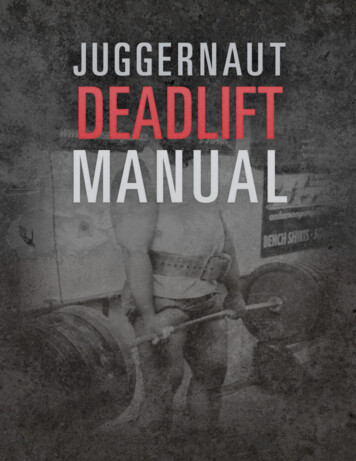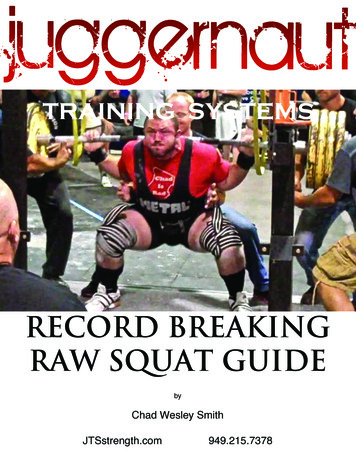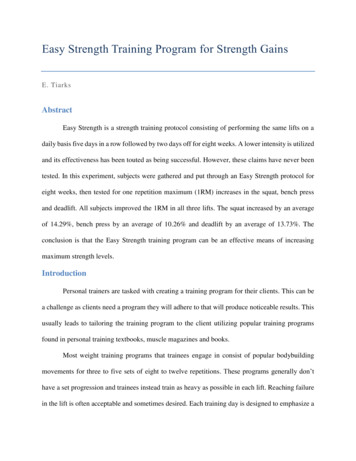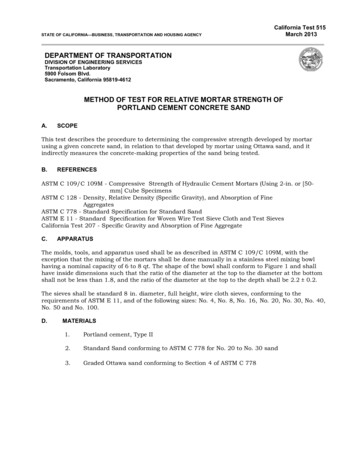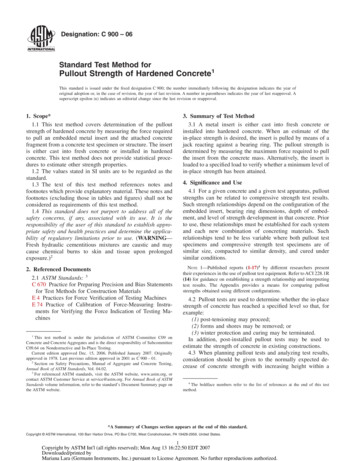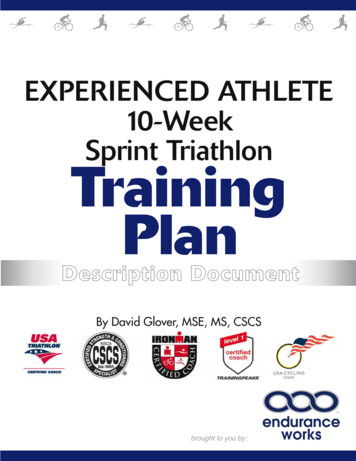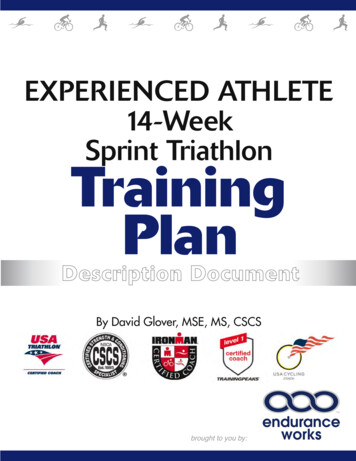
Transcription
The Juggernaut Method: Strength,Power and Conditioning for the Lifter andAthleteBy Chad Wesley Smith2
Before you embark on any physical fitness program,please consult a doctor.This book may not be reproduced or recorded in anyform without permission from the author.3
Table of ContentsAbout the Author-5Incorporating Speed and Power Work-28JumpingSprintingMedicine Ball ThrowsOlympic LiftingAbout Juggernaut Training Systems-6Origin of the Juggernaut Method-6Juggernaut Method Philosphy-7Conditioning-37The ProwlerHill RunningUpper Body Dominant ConditioningThe Program-10Accumulation PhaseIntensification PhaseRealization PhaseChoosing Your Working MaxThe PercentagesMoving Up Your Working MaxPutting It All Together-39Sample Templates4 Days Per Weekwith Speed/Power workwith Conditioningwith Everything3 Days Per Weekwith Speed/Power workwith Conditioningwith Everything2 Days Per WeekUsing 5/3/1 forassistanceThe Deload-17Squat and Deadlift Tips-17Setting Up Your Training Plan-184 Days a Week3 Days a Week2 Days a WeekThe Warmup-20Wrapping It Up-44Assistance Work-23What I Actually DoWestside for Skinny BastardsPeriodization BibleThe Triumvirate5/3/1 as Assistance4
About the AuthorChad Wesley Smith, 24, is the owner and head performance coach at JuggernautTraining Systems in Laguna Hills, CA. Juggernaut strives to provide serious athletes, from juniorhigh to the professional ranks in any sport, with the most comprehensive training andnutritional counseling possible to help them reach their goals.Chad burst onto the national track and field scene in 2009 by throwing a PR of 63 feet 10 ¼inches in the shot put, which ranked him 17th among all American athletes that year. Smith wontwo NAIA national championships in 2009 and was ranked 3rd among all US born collegians. Histrack exploits allowed him to join the Q&A/Training Log staff at EliteFTS.com, which in turn ledhim to begin competing in powerlifting. In October 2010, Smith competed in his firstpowerlifting meet where he totaled 1962 pounds, using only a belt and knee wraps. Smith’s1962 pound total included a squat of 800 pounds. Chad has now turned his attentions fromtrack and field to powerlifting in an effort to break the great Jon Cole’s longstandingunequipped 2364 pound total record in the 308 pound weight class.5
About Juggernaut Training SystemsJuggernaut Training Systems opened its doors for business in September 2009. Thefacility is home to 6000 square feet of dedicated training space, split between turf for sprinting,agility and plyometric work, and a weightroom outfitted with the world’s best equipment fromElite Fitness Systems.Juggernaut specializes in personal, small group and team training, and has workedextensively with athletes competing in football, jiu-jitsu/MMA, water polo, swimming, soccer,basketball, volleyball, track and field, and triathlon.Learn more about Juggernaut Training System’s training philosophy, products andservices at JTSstrength.com.Origin of the Juggernaut MethodThe Juggernaut Method grew out of some simple training cycles I had my athletes doing.They were doing something to the effect of: Week 1-5x5 at 70-75%, Week 2-3x5 at 80%, Week3-Work to a 5rm. Now, I normally intend for a 5rm to be done around 85% and my athleteswould complete their set of five with 85% and then often another with 5-15 pounds more. Theywould then either perform another wave of 5’s with a new exercise or move onto a similarprogram of 3’s in the same lift. This program worked very well.During a break from my track competitions I decided to give this plan a try myself. In thesquat the first week, I did 455 for 5x5, the next week I built up to 495 for 3x5 and in the thirdweek, I did 545 for 5 reps. Immediately upon racking the last rep, I had a realization: I shouldhave kept going.6
Five reps wasn’t hard, I could have done eight, and should have. That began the processof me critically thinking about this simple program, fine tuning it and making it grow into whatyou see here.The Juggernaut Method has grown out of three main influences: Jim Wendler’s 5/3/1,the training of the great Doug Young and Block Periodization. From 5/3/1 it takes the idea of aprogressive overload system of percentages, making small incremental gains, setting rep maxesand simplicity.Doug Young, a tremendous physical specimen and top bench presser from the 1970’s,utilized rep records to influence his training weights on a weekly basis. Young’s training wouldfocus on a final limit set each session. For example, he would perform 4x6 for a few weeks, butinstead of performing only six reps on the last set, he would perform as many as possible andfor every rep beyond six completed, he would adjust the next weeks weights accordingly. TheJuggernaut Method borrows this idea of adjusting the athlete’s training weights based on theirperformance, instead of just a standardized number.Doug YoungJim Wendler7
When I say that the Juggernaut Method has been influenced by Block Periodization, it ismore in spirit than in practice. Block Periodization is broken into three phases: Accumulation-ahigh volume general phase; intensification-intensity now increases along with specificity, whilevolume decreases; and realization-in which intensity reaches a peak during the competitiveseason. I have borrowed this language in the form of an Accumulation, Intensification andRealization week within each training wave. I will discuss the idea behind each week a bit later.Juggernaut Method PhilosophyThese are guidelines that are applied to this program and probably should be to almostevery successful program out there today.Big MovementsI probably sound like a broken record by saying that big, compound, multi-joint lifts willyield the greatest strength and mass gains while also doing the best job of building inter- andintra-muscular coordination. Besides, no one cares how much you can leg extension, and if theydo, you shouldn’t care what that person thinks anyway.8
Start Out Light and Make Incremental Gains Driven by Your ResultsJim Wendler always emphasizes starting out light and progressing slowly, and because I,like any other red blooded American male, want to be like Jim and have him think I’m cool, willalso emphasize this. Starting out light affords you the ability to progress for a longer time. Italso ensures that you will make more lifts, which is a key that many young and/orinexperienced lifters miss. Making lifts makes you stronger. Missing lifts doesn’t. I’m not a bigfan of forced reps. I want my athletes to make their reps on their own. Missing reps is a badhabit that you don’t want to get in, so keep your starting weights conservative and stay out ofthis habit.Moving up your weights from week to week is very necessary to make progress, and isthe most basic form of progressive overload. How much to move them from week to week,though, is a more complicated issue. I want my athletes to be motivated to push their rep maxesas hard as possible and to motivate them toward this, I want their weekly incrementalimprovements to be driven by their rep maxes. I will explain later how this will work.Setting Rep RecordsRep records are an integral part of this program. Too many athletes are absorbed intheir 1-rep max. This program has been very frustrating in that sense to some of my athletesbecause I won’t allow them to take a 1-rep max for such a long time. They will say something tothe effect of, “I really wanna see if I can bench 250 today.” I’ll tell them, “No, but when you get250 on the bar, you are gonna do it for more than 1 rep.” Setting rep records in the 3-10 reprange not only will indicate your strength gains, it is also less stressful on the joints and CNS.Rep records can also be easily compared using the following equation:(Weight x Reps x .033) Weight Projected MaxBe mindful that rep records in the 8 rep range aren’t as accurate as projections fromthe lower range. Take this into account when comparing rep records from vastly different repranges.9
SimplicityThe more I learn about training, the seemingly more simple my training becomes. If youlook at most top lifters, their programs are very different, though they all will have a few keythings in common. They bench, they squat, they deadlift and they break PR’s. Focusing on biglifts, good technique and making small improvements each session will yield you great resultsin the long run. Strength is a long term investment. Many top lifters have added a few pounds ofmuscle per year and a few pounds to their lifts per year, but those years add up. Consistency isking, so be patient, stay consistent and you will make great progress.The ProgramThe Juggernaut Method is a simple program, divided into 4 waves (10’s, 8’s, 5’s and 3’s).Each wave consists of three phases. These phases consist of four training sessions each. It isdesigned to be used on the four big lifts: Bench Press, Squat, Military Press and Deadlift.Accumulation PhaseThe accumulation phase is the beginning of each training wave. They are high volumesessions designed to allow you to develop the skill of the lift, increase work capacity andbecome masterful within the given rep range.10
Intensification PhaseThe intensification phase will increase the intensity from the accumulation phase whilereducing the volume by approximately 60%.Realization PhaseThe realization phase is when the gains of the past wave come to fruition in one set ofmaximal reps.Choosing Your Working MaxIt is important to start out light with your working max. Your working max is thenumber that all your percentages will be based off of. Being conservative in choosing yourinitial working max is key to making progress over the long term. I suggest taking your 1-rm(an actual 1-rm or 3r-m that you have done within the past six weeks, not a theoretical max orsomething you did back in the day) and then take 90% of that. So if you recently benched315x1, you will use 285 as your working max.The PercentagesThese are the sets, reps and percentages that you will use for each phase and each wave.11
AccumulationIntensificationRealization10s Wave8s Wave5s Wave3s Wave55%x5, 62.5%x5,60%x3, 67.5%x3,65%x2, 72.5%x2,70%x1, 7.5%x4x575%x7x382.5%x5x350%x5, 60%x3,50%x5, 60%x3,50%x5, 60%x3,50%x5, 60%x3,75%xAMAP80%xAMAP80%x1,80%x1, 85%x1,70%x1,70%x2, 75%x1,The Last Set70%x2, 75%x1,85%xAMAP70%x2, 75%x1,90%xAMAPThe last set each week is not necessarily done for the written reps, but will be done formaximal or near maximal reps.For example, during the Intensification Phase of the 8’s Wave, an athlete with a workingmax of 500 pounds in the squat could have a training session that looks like this 300 (60%) x3340 (67.5%) x3365 (72.%) x8, 8, 11The last set, however, is not necessarily an all out effort, nor should it be. Training tofailure week after week is taxing to the body and a difficult task to recover from, so it isimportant that you pick your battles and have a goal each week.During the Accumulation Phase I suggest that an athlete leave 2-3 reps in the tank ontheir final work set. So once the minimum, prescribed reps have been completed, an athlete cancontinue performing reps but should be mindful to stay 2-3 reps shy of failure.12
During the Intensification Phase an athlete should end their final set 1-2 reps shy of failure.During the Realization Phase, no reps should be left in the tank. Maximal effort isrequired on the AMAP (as many as possible) set.It is also important for you to have a goal in mind for your final set each week. Do notstep under the bar for the final set with the mindset that you are just going to see how you feel.You should know at the beginning of each wave what your goal is for the final set of each phase.Having set goals will be of immeasurable benefit in your training. Write them down, tell them toyour training partners, and own those numbers.Moving Up Your Working MaxThis is the most important part of this program. Your working max will be adjustedat the end of each wave depending on your performance during the Realization Phase. Forevery rep you perform over the standard (The standard is 10 in the 10’s Wave, 8 in the 8’sWave, etc) you will move your working max up a set amount.[(Reps Performed – Standard) x Increment per rep] Working Max New Working MaxFor example, an athlete with a working max of 405 pounds in the squat who performs 12 repsduring the realization phase of their 8’s wave on the squat using a 5 pound increment per repwould do the following:[(12-8) x 5] 405 425The amount that is used for the increment per rep varies. You can choose to either moveyour max up 2.5 pounds for upper body lifts and 5 pounds for lower body lifts per rep or 1.25pounds for upper body lifts and 2.5 pounds for lower body lifts per rep. I also advise setting acap on the amount which you can move your working max up. This cap should be set at 10 repsabove the standard. So if an athlete performed 22 reps during their 10’s wave, which is 12 repsbeyond the standard, only 10 of those reps would be considered when adjusting the workingmax. These very high reps are common in young or inexperienced athletes who are performingtheir first waves. Which of these increment per rep options you choose to use is very importantand dependent on a few things.13
1) Strength-If you are strong and have a high working max (400 pounds in a given lift)it is less significant for you to move your working max up by 2.5 and 5 pounds per repthan an athlete with maxes in the 150-300 pound range.For example, an athlete with a 450 pound working max in the deadlift who moves theirworking max up 20 pounds from one wave to the next is only making a jump of 4.4%,while an athlete with a 205 pound working max in the bench press who also tries tomake a 20 pound jump from one wave to the next is making 9.8% jump. It will be muchmore difficult for the athlete with the lower working max to make the
The Juggernaut Method is a simple program, divided into 4 waves (10’s, 8’s, 5’s and 3’s). Each wave consists of three phases. These phases consist of four training
